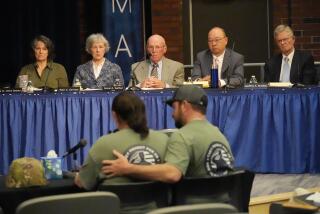Study Asks Army to Rely More on Guard, Reserve
- Share via
WASHINGTON — A landmark report commissioned by Congress to help shape the debate over how to revamp America’s armed forces says the Army will have to rely more on combat units from the National Guard and Reserve in coming years and calls for integrating both more fully with active-duty forces.
The yearlong review, conducted by the Santa Monica-based RAND Corp., also recommends that the Army become responsible for making Guard and Reserve units combat-ready once they are mobilized for deployment and that it set up a series of new training commands to carry out that job.
The long-awaited document, being sent to lawmakers privately over the weekend, is certain to spark controversy on Capitol Hill, where lobbyists for the National Guard and Reserve have been fighting to keep the organizations intact amid growing pressures for further cuts in defense spending.
Guard officials have been arguing that Congress should concentrate cuts on the active-duty forces and should shift more of the responsibility for the nation’s defense to Guard and Reserve units, which are less expensive to operate.
The 336-page study is expected to be used by the House and Senate Armed Services committees as a basis for restructuring the U.S. military for the post-Cold War era.
The recommendations also come at a time when the incoming Clinton Administration seems likely to propose additional defense spending cuts, which are almost certain to crimp force levels even further.
The changes called for in the report would cut active-duty troop strength in the Army to 525,000--down from 550,000 now--and would increase the number of Guard and Reserve troops from 542,000 to 679,000--more than the Army wants but less than the Guard is seeking.
But if the RAND recommendations are adopted, the Guard would not retain full control of its own combat units, as it prefers. Instead, Guard troops would be integrated more fully with active-duty soldiers and would be trained by regular Army units as soon as they were called up.
The thrust of the RAND study is that reductions in troop strength since 1990 have already left the Army unable to fight two major wars at once--as is called for in the national military strategy--necessitating the further integration of combat units from the Guard and Reserve.
But the document concedes that, as shown in the Persian Gulf War, Guard and Reserve combat units do not meet active-duty standards for combat readiness and it takes far longer than expected to get them there. The study estimates the training period at 128 days in future wars.
The document suggests that if U.S. forces are to maintain their ability to fight two wars at once, the Pentagon must mobilize Guard and Reserve units earlier and create special Army training commands to help bring those units up to snuff.
It also suggests integrating active-duty and Guard/Reserve combat forces at the battalion and company level in some cases--rather than having them operate as separate brigade-sized units--to increase prospects that the Guard and Reserve troops will be combat-ready when their units finally are deployed.
The study also recommends transferring some 34,000 combat-support units, such as military police and transportation units, that are now part of the active-duty force to the National Guard and Reserve, largely to save money that could be used to help pay for the extra training.
The fact that Guard units were not able to meet combat requirements as rapidly as expected has been cited as one of the major disappointments in the Gulf War. By contrast, service units--such as military police and transportation companies--from the Guard and Reserve performed well.
A post-war assessment by the Army estimated that it probably would take 90 days of training to make Guard and Reserve units combat-ready--far longer than had been anticipated. The National Guard has insisted that only 45 days would be required.
The report suggested only modest changes for the current Air Force Guard and Reserve structure, which generally performed well in the Gulf War, and for Navy and Marine reserve units. Most of the report dealt with Army operations.
More to Read
Sign up for Essential California
The most important California stories and recommendations in your inbox every morning.
You may occasionally receive promotional content from the Los Angeles Times.













